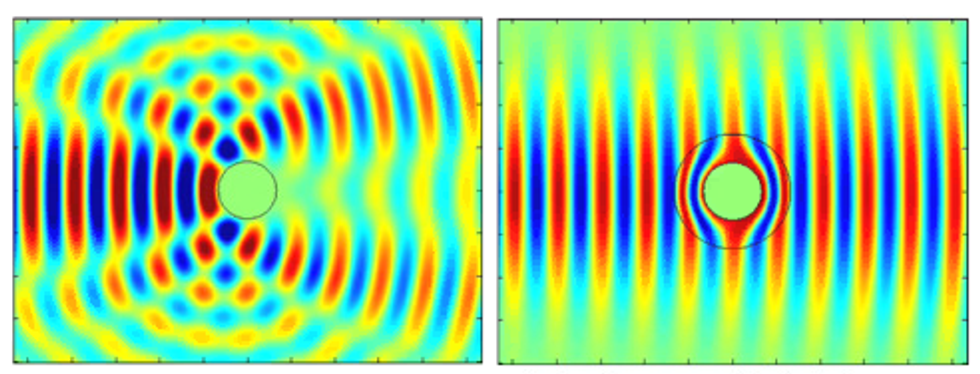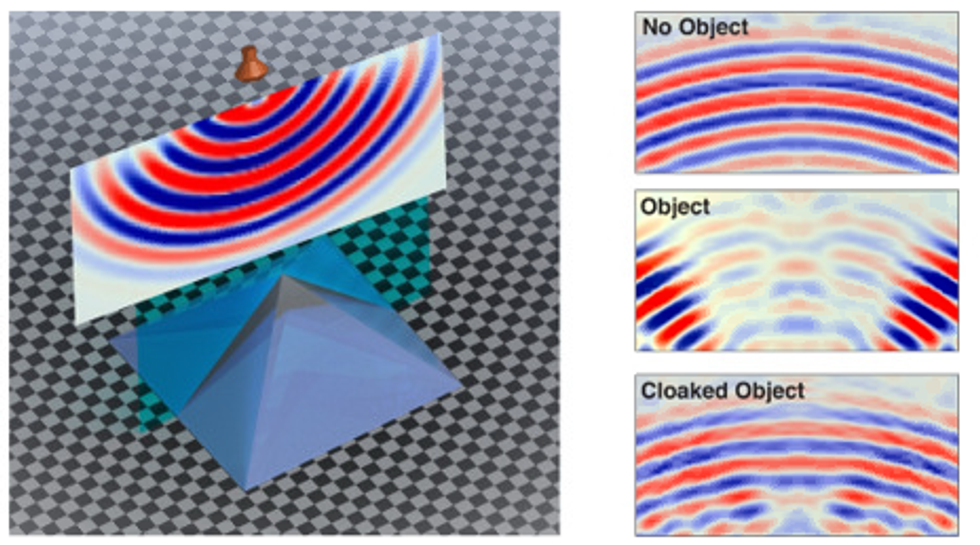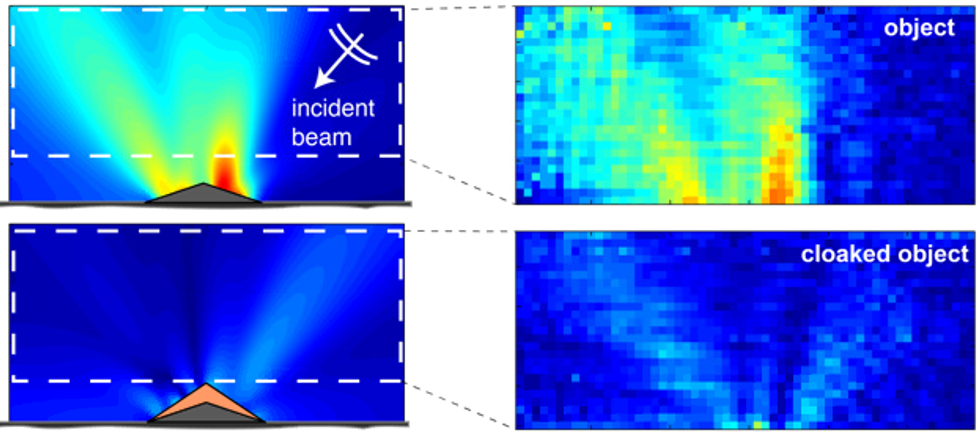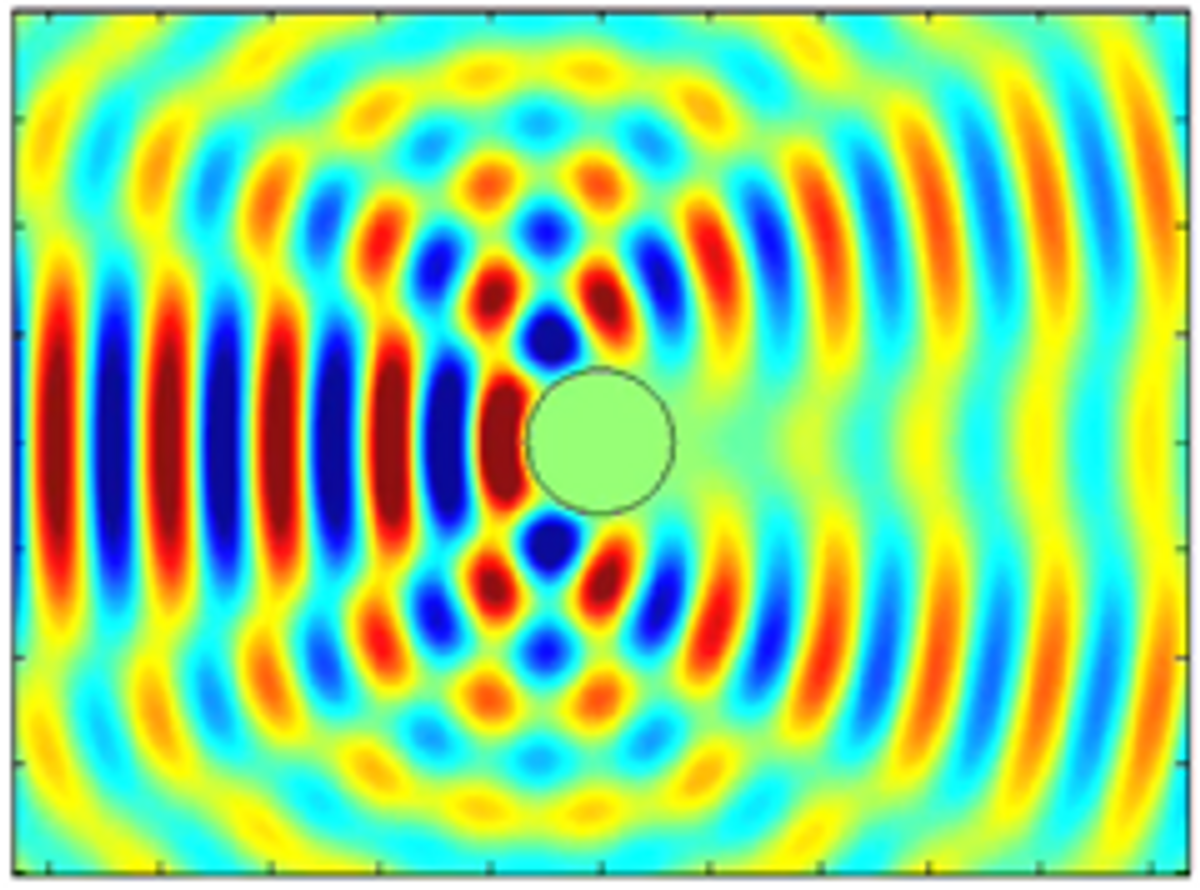The following is an excerpt from COMSOL News 2017 Acoustics Edition.
BY GEMMA CHURCH and VALERIO MARRA
Metamaterials are man-made, specially fabricated materials featuring properties never found in nature, such as zero or even negative refractive index. The result is the creation of cutting-edge designs and functionality, such as superlenses and sound absorbers. Recent research efforts have turned to the arbitrary manipulation of sound waves using metamaterial devices, including making an object acoustically invisible.
The research has been a success. Using little more than a few perforated sheets of plastic and a staggering amount of mathematical modeling and numerical simulation work, engineers at Duke University have demonstrated the world’s first 3D acoustic cloak. The device bends sound waves smoothly around an object, fills in the shadow and gives the impression the waves went straight through the surrounding air.
Acoustic invisibility is just one aspect of the broad concept of transformation acoustics, in which carefully designed materials can deform or control sound waves in almost arbitrary ways. From sci-fi to mundane, there are many possible applications of this technological breakthrough.
Designing silent metamaterials
Duke University, alongside MIT, University of California, Berkeley, Rutgers University, and the University of Texas at Austin, forms part of a five-year research program sponsored by the US Office of Naval Research to develop new concepts for acoustic metamaterials with effective material parameters that can be fabricated in the real world. Steve Cummer, professor of electrical and computer engineering at Duke University, said: "Mathematical models are the starting point. The acoustic metamaterial designs are optimized through numerical simulations, which we then translate into modern fabrication techniques and experimentally test."
One focus of the group’s current research efforts is on developing acoustic metamaterial structures that can be used in water-based environments, including the human body, to arbitrarily transform and control incoming sound waves. Acoustic cloaking structures (Figure 1) have proven a useful testbed for demonstrating the arbitrary control enabled by transformation acoustics. Designing for aqueous environments represents a shift in metamaterial research, which has evolved from electromagnetic cloaking and transformation optics, to acoustic cloaking and transformations in 2D and then 3D structures in air.

COMSOL Multiphysics® software has been a vital commodity at every stage of the research, going back to the very early days of electromagnetic cloaking. Cummer said: "In the first paper where we showed simulations of electromagnetic cloaking using real electromagnetic material parameters, we used COMSOL® software specifically because it was one of the only electromagnetic software tools that had the ability to accommodate arbitrarily anisotropic electromagnetic material parameters."
To attack the acoustics problem, the researchers began with deriving the needed material properties. Cummer explained: "To arbitrarily control sound using transformation acoustics, we first apply a coordinate transformation to describe how you would like to bend or twist or deform the sound field in a particular device. Once you’ve defined that coordinate transformation, then you can derive the effective material parameters you need to create that particular deformation of the sound field."
That resulting set of material parameters is almost always anisotropic, which means the material properties behave differently in different directions. To handle this the researchers needed to be able to change the equations representing the physics being simulated. "COMSOL makes it so easy and relatively straightforward to manipulate the material properties and the underlying dynamic equations. This was really important because we could add that one extra twist of the anisotropy to the model and start simulating some of the designs that we were exploring within the transformation acoustics approach," Cummer added.
The resulting real-world designs have been very successful and their performance matched the simulations "astonishingly well", according to Cummer. "The gold standard in metamaterials publications these days, to show whether a structure works the way you want it to and produces the physics you want it to, is to take a measurement of the full sound field produced by the acoustic metamaterial and compare that to the simulation," he added.
COMSOL Multiphysics® software is able to consistently achieve such agreement, even when human error has tried to derail the research. In an earlier project, a 2D acoustic cloaking shell featuring a series of tiny holes was designed and built, but the experiments did not match the simulations. The team was flummoxed and could not see any viable reason for the discrepancy. They suddenly realized that holes in the structure were the wrong size due to a mix up during its construction.
Cummer said: "The efficiency of COMSOL has been pretty critical in our work because we can do numerical simulations of both the idealized parameters and then of the full structure that we would actually build, to confirm that they behave the same way."
Fabricating and testing an acoustic metamaterial
The design of a 3D acoustic cloaking shell employed the same basic perforated plate structure in a pyramidal shape (Figure 2) under which an object could be hidden from sound waves. The structure may at first appear to be relatively simple in its design, but many factors are balanced to achieve the desired acoustic transformation, including the hole diameter, the spacing between the plates, and the angle of the plates. All of these parameters combine to give just the right amount of acoustic anisotropy to make the structure work.
This pyramid structure was the world’s first 3D acoustic cloak, and laboratory measurements confirmed that it is capable of rerouting sound waves to create the impression that both the cloak and anything beneath it are not there (Figure 3). The device works in all three dimensions, no matter which direction the sound is coming from or where the observer is located, and holds potential for future applications such as sonar avoidance and architectural acoustics.

Given the necessary thickness of the acoustic metamaterial shell, the latter is the more plausible option, where such acoustic cloaking devices could be used to optimize the sound in a concert hall or dampen it in a noisy restaurant environment, for example. Cummer said: "The cloaking material is not just magic paint you can spray onto something. Generally speaking, that’s not the way that these kind of ideas can be deployed in practice."

Beyond the design stage, modeling and simulation have been used to predict the quantitative performance of metamaterial shells like this, including a detailed analysis of the scattering from a 2D cloaking shell implementation (Figure 4). Not only does this show how much the scattered field is reduced by the shell, but COMSOL accurately predicts the amount of scattering reduction given design tradeoffs made in the fabrication of the acoustic metamaterial.

From air to water: different medium, new challenges
Attention has now shifted to getting acoustic metamaterials to work in an aqueous environment, such as underwater or inside the human body. Multiphysics modeling is used as the primary design tool to first map the previously designed structures and run simulations in order to test how they will perform in water. The move from air to water is more difficult than it sounds.
The problem is that the mechanical properties of air are dramatically different from those of water. Cummer explained: "That’s why in air we can get away with building acoustic metamaterials in plastic, or whatever solid is convenient, as the solid can act essentially as a perfectly rigid structure to control the sound field flow. It doesn’t really matter what it is made of."
But the mass density and compressional stiffness of water are not so different from solid materials. "When sound waves hit a solid structure in water, the mechanical properties of that solid start to matter a lot. We need to come up with new techniques in the design phase to be able to control how that sound wave energy interacts with the solid so that we can maintain the properties we want," he added.
"The ability to easily merge acoustics and structural mechanics is essential, especially when we’re dealing with structures in water where we can’t ignore the mechanical responses of the solid material that we’re using to build the metamaterial. In airborne acoustics, we can get away with treating the solid as a material that is infinitely rigid, which is easy and computationally efficient, but for the water-based material it is essential to be able to consider fluid-structure interaction, which is easy with COMSOL."
The leap from research into commercially viable acoustic metamaterial structures is far from simple and means such structures must be able to be fabricated reliably and repeatably. Cummer concluded: "The next step to creating any acoustic metamaterial is that it is able to hit specific quantitative metrics. That means we have a more complicated design process, but that’s exactly what COMSOL is designed to do. [It allows] much more design iteration and clever use of optimization to identify degrees of freedom in the design that can be manipulated to then hit those specific numerical targets. That’s definitely the key going forward in transitioning these ideas from proof of concept demonstrations to something that’s actually practical and deployable in the real world."
To read more about multiphysics simulation in acoustics applications, click here.



